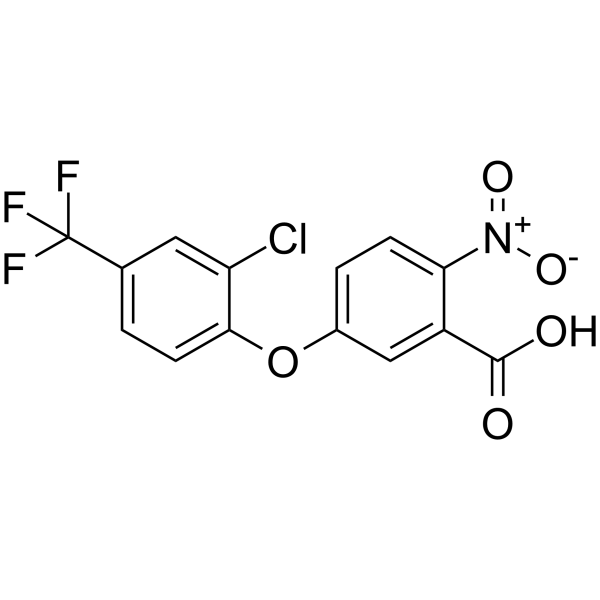
Acifluorfen
CAS No. 50594-66-6
Acifluorfen( —— )
Catalog No. M28315 CAS No. 50594-66-6
Acifluorfen, a protoporphyrinogen oxidase (PROTOX) inhibitor herbicide, promotes the accumulation of protoporphyrin IX (PPIX), and induces tumors in the rodent liver. Acifluorfen causes strong photooxidative destruction of pigments and lipids in sensitive plant species.
Purity : >98% (HPLC)
 COA
COA
 Datasheet
Datasheet
 HNMR
HNMR
 HPLC
HPLC
 MSDS
MSDS
 Handing Instructions
Handing Instructions
| Size | Price / USD | Stock | Quantity |
| 50MG | 37 | Get Quote |


|
| 100MG | 55 | Get Quote |


|
| 200MG | 80 | Get Quote |


|
| 500MG | Get Quote | Get Quote |


|
| 1G | Get Quote | Get Quote |


|
Biological Information
-
Product NameAcifluorfen
-
NoteResearch use only, not for human use.
-
Brief DescriptionAcifluorfen, a protoporphyrinogen oxidase (PROTOX) inhibitor herbicide, promotes the accumulation of protoporphyrin IX (PPIX), and induces tumors in the rodent liver. Acifluorfen causes strong photooxidative destruction of pigments and lipids in sensitive plant species.
-
DescriptionAcifluorfen, a protoporphyrinogen oxidase (PROTOX) inhibitor herbicide, promotes the accumulation of protoporphyrin IX (PPIX), and induces tumors in the rodent liver. Acifluorfen causes strong photooxidative destruction of pigments and lipids in sensitive plant species.(In Vitro):The effect of Acifluorfen on glutathione and ascorbate levels in cucumber (Cucumis sativus L.) cotyledon discs is investigated to assess the relationship between herbicide activity and endogenous antioxidants. Acifluorfen decreases the levels of glutathione and ascorbate over 50% in discs exposed to less than 1.5 hours of white light (450 microeinsteins per square meter per second). Acifluorfen also causes the rapid depletion of ascorbate in far-red light grown plants which are photosynthetically incompetent. (In Vivo):Dietary treatment with 2500 ppm Acifluorfen for up to 13 weeks increases Cyp2b10 expression in the livers of wild-type mice, but not in CAR-knockout (CARKO) mice. Microscopically, Acifluorfen treatment-induces cytotoxic changes, including hepatocellular necrosis and inflammation, and causes regenerative changes accompanied by prolonged increases in the numbers of proliferating cell nuclear antigen-positive hepatocytes in WT mice .
-
In VitroThe effect of Acifluorfen on glutathione and ascorbate levels in cucumber (Cucumis sativus L.) cotyledon discs is investigated to assess the relationship between herbicide activity and endogenous antioxidants. Acifluorfen decreases the levels of glutathione and ascorbate over 50% in discs exposed to less than 1.5 hours of white light (450 microeinsteins per square meter per second). Acifluorfen also causes the rapid depletion of ascorbate in far-red light grown plants which are photosynthetically incompetent.
-
In Vivo——
-
Synonyms——
-
PathwayOthers
-
TargetOther Targets
-
RecptorDyrk1A|Dyrk1B
-
Research Area——
-
Indication——
Chemical Information
-
CAS Number50594-66-6
-
Formula Weight361.66
-
Molecular FormulaC14H7ClF3NO5
-
Purity>98% (HPLC)
-
SolubilityIn Vitro:?DMSO : 25 mg/mL (69.13 mM)
-
SMILESOC(=O)c1cc(Oc2ccc(cc2Cl)C(F)(F)F)ccc1[N+]([O-])=O
-
Chemical Name——
Shipping & Storage Information
-
Storage(-20℃)
-
ShippingWith Ice Pack
-
Stability≥ 2 years
Reference
1.Ogawa Y, et al. Development of a novel selective inhibitor of the Down syndrome-related kinase Dyrk1A. Nat Commun. 2010 Oct 5;1:86.
molnova catalog



related products
-
Coclaurine
Coclaurine is a natural product.
-
Momordicoside X
Momordicoside X displays moderate insulin secretion activity.
-
Buserelin Acetate
Buserelin Acetate is an agonist of gonadotropin-releasing hormone receptor(GnRHR).



 Cart
Cart
 sales@molnova.com
sales@molnova.com


